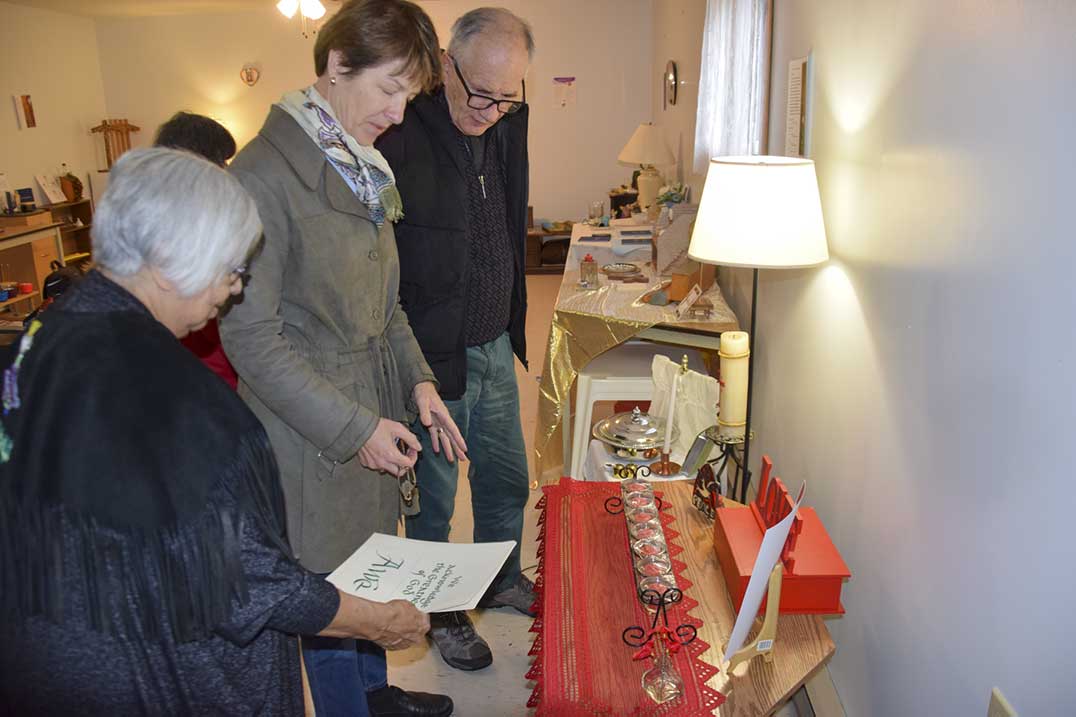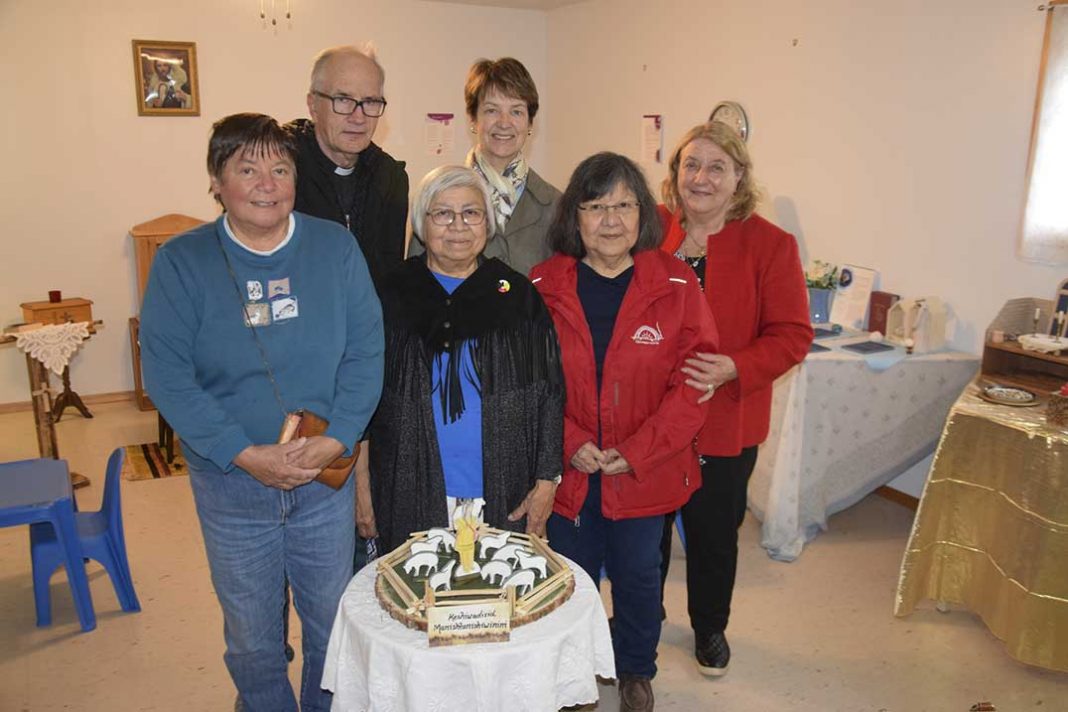KABONI – The greying of the pews is an ongoing phenomenon in the mainstream traditional churches in the Western world as younger parishioners drift away under the pressures of the modern world and a drift toward growing secularism. A group of devout Catholic Anishinaabekwe in Kaboni decided to tackle those challenges by tending to the roots faith in pre-school children and constructing an Atrium in the church at St. Anthony Daniel Parish. An Atrium is a hands-on religious teaching environment aimed at children ages three to six, under the auspices of the Catechesis of the Good Shepherd Association of Canada—the first to be established on a First Nation community in Ontario.
Rosella Kinoshameg discovered the concept of the Atrium through a visit to a church in Guelph. “We went to Guelph where we have an exchange parish, like a sister church, and met Therese (Wright) who took us on a tour of the Atrium there,” said Ms. Kinoshameg. “I said ‘this is what we need at home’.”
Ms. Wright told her that there was a course available to learn more about the Atrium concept and Ms. Kinoshameg threw herself into the process with gusto, travelling to Guelph to take the course. “Once a month, five times,” said Ms. Kinoshameg. Then came 10 hours of observation, seeing first hand how the Atrium operates in practice.
The practical observation is important, noted Ms. Wright. “When you take the course you are in a classroom setting,” she explained. “When I finished the course in Toronto, I had never actually been in an Atrium, so I spent the next year working in an Atrium so I could see how it operated with the children day-to-day.”
Dale Shain of Little Current and her family were involved in the project as well.
“Rosella and I are both trained catechists for Level 1 of the Good Shepherd program,” she said. “I graduated in 2017 and Rosella last May. We are delivering the program together and we collaborated in pulling together the Atrium itself.”
Ms. Shain works on the printed materials and constructed the material with the assistance of “daughter Theresa for artwork, Maggie for carpentry and friends,” she said, “Julia Short donated wood and cut 3D materials. Judy Martin showed me how to do book binding.”
“I learned about the existence of the Atrium program from the CBC show Tapestry during their show about children’s spirituality,” she said. “I did my Google homework and found a year-long course in Guelph. I wasn’t seeking certification or planning to work in an Atrium (North Bay was the only one in our diocese in 2017—now there’s one in Sault Ste. Marie and soon there will be another in Lively). I took the course as a grandmother wanting to know how to honour the natural spirituality of her granddaughters and help give it some form. I took on more than I planned for by attending this rigorous course over five weekends in Guelph. Lots and lots of homework.”
“I think it is fantastic,” said Father Tony Baranowski, who was officiating at the launch of the Kaboni Atrium with a blessing of the stations. “Hopefully it will bring in a number of children and, with good instructors, I think it will grow as the time goes by.”

“An important aspect about the Kaboni Atrium is that all our prayers and parables are translated into Ojibwe with the assistance of several fluent speakers in Wiikwemkoong,” noted Ms. Shain. “This is of huge significance to the Canadian association and internationally. We’re providing an Anishabek theme to our work. There is a Korean Atrium in Toronto that also incorporated their cultural images.”
The Catechesis of the Good Shepherd is a religious education movement that began almost 70 years ago and has since grown to more than 37 countries. Founded by Hebrew scholar Sofia Cavalletti and Gianna Gobbi (a former assistant to Montessori School founder Maria Montessori) the teaching concept is based on a sound foundation of how children develop and their capacities at different ages.
The Atrium itself began, literally, in the atrium (an open space at the entrance) of a church in Rome—hence the adoption of the name for the program. The space itself is modelled after the Montessori learning environment, with a heavy emphasis on hands-on materials. These include small dioramas, models of various objects and figures, maps of ancient Israel, timelines of history and other material aids for studying scripture and liturgy.
Most of the Atria are designed for children aged three to six, but there are also second and third phases aimed at six- to nine-year-olds and nine- to 12-year-olds. The difference between the Atrium method of religious instruction and a more traditional approach is four-fold.
First, the theology of the child is aimed at growing with the child and developing a child’s grasp of language along with the child at their pace, rather assuming they are ready to be instructed about God.
Second, the role of the adult is to be more of a spiritual director, rather than a teacher as such. The adult is encouraged to listen to the children and to matching the child’s questions with resources from the faith tradition, thus becoming a co-learner as opposed to instructor.
Third, the Montessori-style of teaching recognizes that children learn more from the environment around them than through lectures and lessons. Five core themes are introduced at age three and developed each year up to age 12, rather than being introduced separately in different years. Those themes are the incarnation, the Kingdom of God, the paschal mystery, baptism and the Eucharist.
Finally, the Atrium focusses on essentials, as Ms. Cavelletti saw that children quickly become restless when inundated with peripheral material, so the method seeks to use the fewest words possible, eschews busy-work and only introduces those themes that meet the essential requirements of the children.
While the Atria were developed under the auspices of the Roman Catholic church, they have proven to also be an effective bridge between Christian denominations and helping to lessen the gulf between liberal and conservative Christians. Participants in formation courses have included Orthodox, Anglican and Lutheran adherents as well as Catholics. The Kaboni Atrium could be thought of as being an Anishinaabe Catholic initiative—and Ms. Kinoshameg is hoping to see the concept spread to other parishes in Anishinaabe territories.
More can be learned about the Catechesis of the Good Shepherd and the Atrium concept a www.cgsac.ca.





